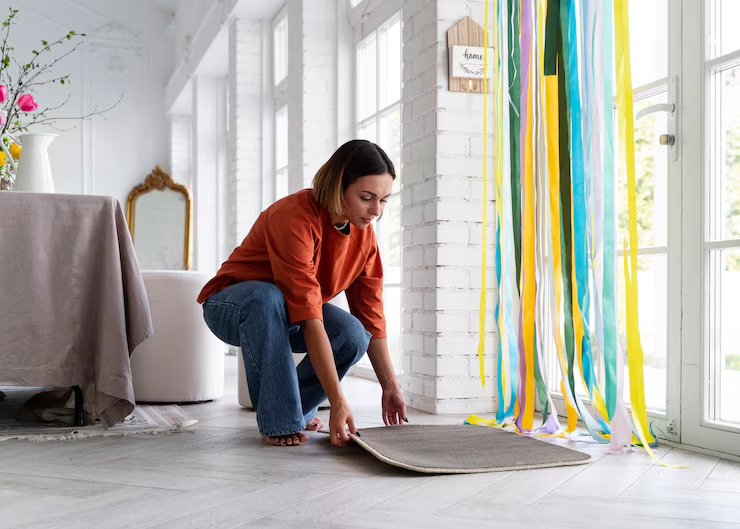How to Clean Very Dirty Laminate Floors
- Staff Desk
- Jun 19
- 4 min read
Updated: Oct 28

Laminate flooring is a top choice among homeowners and interior designers alike thanks to its affordability, durability, and attractive design options. It mimics the appearance of natural wood, tile, or stone—offering style at a fraction of the cost. However, to keep your laminate floors looking beautiful for years, it’s important to understand the proper care and cleaning practices that this flooring type requires.
In this guide, we’ll break down what laminate flooring is, why it needs special care, and how to clean and maintain it effectively.
What Is Laminate Flooring?

Laminate flooring is a multi-layer synthetic flooring product that’s engineered to be both durable and stylish. It is constructed in the following layers:
Wear Layer: The top layer is a clear, protective coating designed to resist scratches, scuffs, and stains.
Photographic Layer: Just beneath the wear layer lies a high-resolution image that simulates the look of wood, tile, or stone.
Core Layer: Made of high-density fiberboard (HDF), this is the thickest part of the laminate plank and provides structure and stability.
Backing Layer: A bottom layer that offers moisture resistance and helps with installation over various subfloors.
Thanks to these layers, laminate flooring offers a balance of aesthetics and performance, making it suitable for many areas of the home.
Why Laminate Floors Need Special Care

Though tough and resistant to daily wear, laminate flooring is not invincible. It differs from solid hardwood and tile in key ways that require more mindful maintenance:
Moisture Sensitivity: Laminate is not waterproof. Prolonged exposure to standing water can cause the fiberboard core to swell or warp.
Surface Coating: Harsh chemicals or abrasive tools can damage the wear layer, leading to dullness or discoloration.
Non-Refinishable: Unlike hardwood, laminate flooring cannot be sanded down or refinished. Once it’s damaged, replacement is usually the only option.
By understanding these limitations, you can adjust your cleaning habits to keep your floors in pristine condition.
Daily and Weekly Laminate Floor Cleaning Routine
Daily Cleaning
Dry Dusting or Sweeping: Use a microfiber mop or a soft-bristle broom to remove dust, pet hair, and debris. Avoid traditional brooms that may scratch the surface.
Vacuuming: You can vacuum laminate floors using a hard floor setting or attachment. Ensure the vacuum doesn’t have a beater bar, as it can scuff the surface.
Weekly Cleaning
Damp Mopping: Use a slightly damp microfiber mop for weekly cleaning. Do not soak the floor. Excessive water is the enemy of laminate.
Mild Cleaners: Use a laminate floor cleaner or a homemade solution of one part white vinegar to three parts water. Spray lightly on the mop (not directly on the floor) and mop in small sections.

What to Avoid When Cleaning Laminate Floors

To keep your floors looking like new, avoid these common mistakes:
Wet Mops and Steam Cleaners: These introduce too much moisture, which can penetrate and warp the planks.
Abrasive Tools: Steel wool, scrub brushes, or rough sponges can damage the protective wear layer.
Harsh Chemicals: Cleaners with bleach, ammonia, or acidic bases can eat away at the finish and dull the floor.
Wax or Polish: Laminate doesn’t benefit from waxing or polishing—these products can actually leave a sticky residue.
Laminate Floor Maintenance Tips for Longevity
1. Prevent Scratches
Use felt pads on furniture legs.
Place mats or area rugs in high-traffic zones and near entryways.
Keep pet nails trimmed and shoes clean.
2. Protect from Moisture
Clean up spills immediately.
Use a mat under pet water bowls and in front of kitchen sinks.
Avoid installing laminate in bathrooms or other very humid areas unless it’s rated as water-resistant.
3. Reduce Sun Exposure
Direct sunlight can fade laminate designs. Use blinds or curtains during peak sunlight hours.
4. Maintain Proper Humidity
Use a humidifier or dehumidifier to maintain indoor humidity between 35%–65%, especially during seasonal changes.
Dealing with Common Laminate Floor Issues

Scratches
Minor scratches can be minimized with a laminate floor repair kit or color-matched marker. Deeper gouges may require replacing individual planks.
Warping or Buckling
This typically happens due to moisture. Address the moisture source and replace the affected boards if needed.
Gaps Between Planks
These can occur with temperature fluctuations. If they don’t return to normal when temperatures stabilize, a professional repair may be required.
Choosing the Right Products for Laminate Floor Care
When shopping for cleaners or tools, look for:
Laminate-specific cleaning sprays
Microfiber mops
pH-neutral solutions
Dry dust mops or vacuums designed for hard floors
Avoid anything that claims to "shine" or "polish" laminate floors, as these can lead to buildup and cloudiness.
Conclusion: Care Today, Beauty Tomorrow
Laminate flooring offers a beautiful, budget-friendly solution for busy homes—but only with proper care. By understanding the nature of laminate and using the right cleaning methods, you can preserve its appearance and extend its lifespan for years.
With just a bit of daily attention and some long-term maintenance habits, your laminate floors will continue to shine and enhance your space without the need for costly repairs or early replacement.


Comments